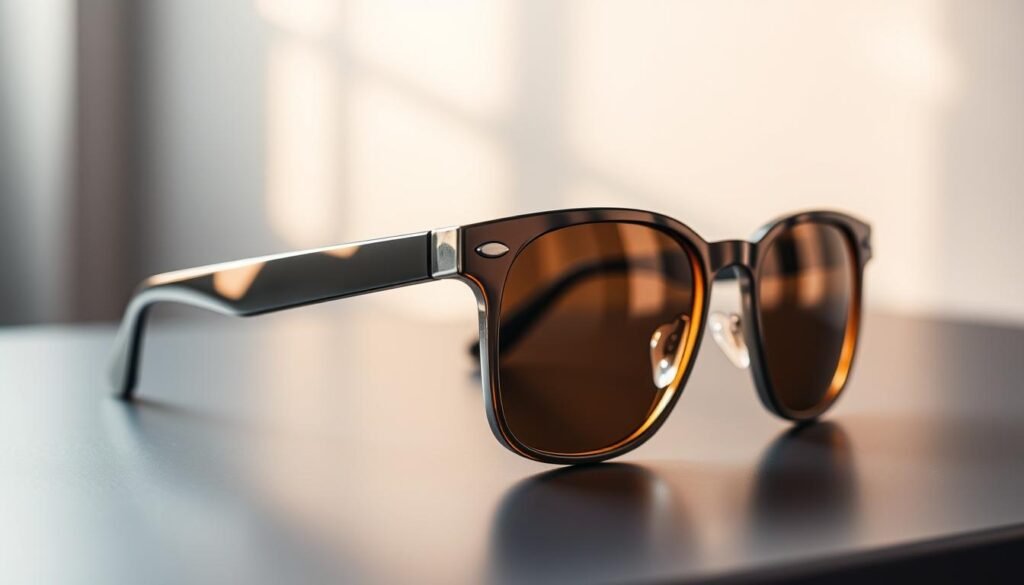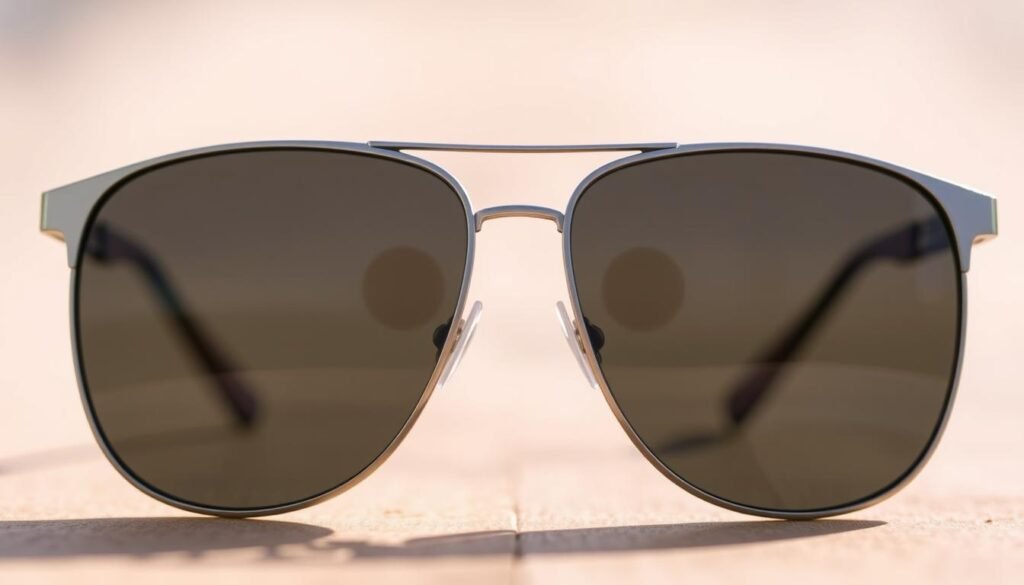Selecting the right sunglasses can be overwhelming with so many styles and features available. However, a good pair of sunglasses is not just a fashion statement; it’s also about protecting your eyes from harmful UV rays.
When it comes to buying sunglasses, there are several factors to consider. You need to think about the shape of your face, the activity you’ll be doing while wearing them, and the level of UV protection they offer.
With the right sunglasses, you can enjoy the outdoors while keeping your eyes safe. In this guide, we’ll walk you through the key considerations for making an informed purchase.
Key Takeaways
- Consider face shape when choosing sunglasses
- Think about the activity you’ll be doing while wearing them
- Ensure they offer adequate UV protection
- Style and comfort are also important factors
- Research different brands and their offerings
The Importance of UV Protection
Protecting your eyes from the sun’s ultraviolet (UV) rays is essential, and the right sunglasses can make all the difference. UV rays are a known risk factor for cataracts, macular degeneration, and eye cancer. Therefore, understanding the level of UV protection your sunglasses offer is crucial.
Understanding UV-A and UV-B Rays
The sun emits two types of ultraviolet rays that can harm your eyes: UVA and UVB. UVA rays penetrate deep into the eye, potentially causing damage to the retina and contributing to conditions like cataracts and macular degeneration. UVB rays are more directly associated with causing eye surface damage, such as photokeratitis, or “snow blindness.” Both types of rays can cause significant harm, making comprehensive protection vital.
Minimum Protection Standards
Not all sunglasses offer the same level of UV protection. To ensure your eyes are adequately protected, look for sunglasses that meet specific standards.
UV400 Rating Explained
A UV400 rating indicates that the sunglasses block 99-100% of UVA and UVB rays up to 400 nanometers. This rating is considered the gold standard for UV protection in sunglasses, ensuring that your eyes are safeguarded against the majority of harmful UV radiation.
CE and FDA Certifications
In addition to the UV400 rating, look for certifications from reputable bodies such as the CE (Conformité Européene) marking or approval from the FDA (U.S. Food and Drug Administration). These certifications indicate that the sunglasses have been tested and comply with specific safety standards for UV protection.
Long-term Eye Health Benefits
Wearing sunglasses with proper UV protection can significantly contribute to your long-term eye health. By blocking harmful UV rays, you reduce the risk of developing UV-related eye conditions. This proactive step can help preserve your vision and eye health for years to come.
- Reduces the risk of cataracts and macular degeneration
- Protects against eye surface damage
- Preserves vision and overall eye health
By choosing sunglasses that offer comprehensive UV protection, you’re not just making a fashion statement; you’re taking a crucial step towards safeguarding your eye health.
Lens Quality and Materials
The material and quality of your sunglasses’ lenses can significantly impact your eye protection and viewing experience. When selecting sunglasses, it’s essential to consider the type of lens material that best suits your needs.
Glass vs. Plastic Lenses
Glass lenses are known for their excellent optical clarity and scratch resistance. However, they are heavier and more prone to shattering upon impact compared to plastic lenses.
Clarity and Scratch Resistance Comparison
Glass lenses offer superior clarity, while high-quality plastic lenses can also provide excellent optical quality. In terms of scratch resistance, glass lenses generally outperform plastic lenses, although coatings can enhance the durability of plastic lenses.
Weight and Safety Considerations
Plastic lenses are lighter and safer than glass because they are less likely to shatter. However, they may not provide the same level of scratch resistance as glass.
| Lens Material | Clarity | Scratch Resistance | Weight | Safety |
|---|---|---|---|---|
| Glass | Excellent | High | Heavy | Low |
| Plastic | Good | Moderate | Light | High |
Polycarbonate and Trivex Options
Polycarbonate and Trivex lenses are highly impact-resistant and lightweight, making them ideal for sports and active use. They offer a good balance between optical quality and safety.
Optical Quality Assessment
When assessing optical quality, consider factors such as distortion, clarity, and the presence of any aberrations. High-quality lenses, regardless of material, should provide clear and distortion-free vision.
Frame Materials and Construction
The construction and material of your sunglasses’ frames can significantly impact their overall performance and aesthetic appeal. When choosing sunglasses, it’s essential to consider the pros and cons of different frame materials.
Metal Frames: Pros and Cons
Metal frames are known for their durability and sleek look. They can be made from various metals, each with its unique characteristics.
Titanium and Aluminum Options
Titanium frames are lightweight and corrosion-resistant, making them ideal for long-term wear. Aluminum frames, on the other hand, offer a great balance between durability and affordability.
Stainless Steel Durability
Stainless steel frames are renowned for their strength and resistance to corrosion. They are a great choice for those seeking durability.
| Material | Durability | Weight | Cost |
|---|---|---|---|
| Titanium | High | Light | High |
| Aluminum | Medium | Light | Medium |
| Stainless Steel | High | Heavy | High |
Plastic and Acetate Options
Plastic frames are versatile and affordable, while acetate frames offer a hypoallergenic alternative with a wide range of colors.
Lightweight Materials for Active Use
For those with active lifestyles, lightweight materials such as titanium and certain plastics can enhance comfort during prolonged wear.
Finding the Right Style for Your Face Shape
Understanding your face shape is crucial in selecting sunglasses that will flatter your features. The right frame can enhance your natural beauty, while the wrong one can detract from it.
Different face shapes are suited to different styles of sunglasses. Let’s explore the best options for various face shapes.
Oval Face Shapes
If you have an oval face, you’re in luck because most sunglasses styles will suit you. Oval faces are balanced, so look for frames that are as wide as your face’s broadest part. Avoid frames that are too oversized or too small.
Round Face Shapes
For round faces, angular frames can help define the features. Rectangular or square frames with sharp corners can add a nice contrast to the soft curves of a round face.
Square and Rectangle Face Shapes
Square and rectangular faces benefit from softer, rounder frames that can help balance angular features. Consider aviators or round sunglasses to add some curves.
Heart and Diamond Face Shapes
Heart-shaped and diamond faces look great with frames that are wider at the bottom. This can help balance a narrower chin. Cat-eye sunglasses are also a great option as they draw attention to the eyes.
Sizing Considerations
Regardless of your face shape, the size of your sunglasses is crucial. Frames should be in proportion to your face size. Oversized frames on a petite face can be overwhelming, while small frames on a larger face can get lost.
By considering both your face shape and the size of the sunglasses, you can find a pair that not only protects your eyes but also enhances your overall look.
Key Features to Look Out For When Buying Sunglasses
To get the most out of your sunglasses, it’s essential to understand the key features that can enhance your visual experience and eye protection. When shopping for sunglasses, several factors can make a significant difference in both functionality and comfort.
Polarization Benefits
Polarized lenses are designed to reduce glare from reflective surfaces, making them particularly useful for driving, fishing, or any activity where glare can be a problem. The polarization process filters out horizontally polarized light, which is the primary component of glare.
Glare Reduction Technology
The technology behind polarized lenses involves a special filter that blocks intense reflected light. This results in reduced glare and improved visual clarity, especially in bright conditions.
When Polarization Matters Most
Polarization is most beneficial during activities like driving, where glare from the road or other vehicles can be hazardous. It’s also valuable for water sports, skiing, and hiking, where reflective surfaces are common.
Photochromic Lenses
Photochromic lenses change tint in response to changing light conditions, providing convenience for users who move between indoors and outdoors. These lenses darken in bright light and lighten in low light conditions.
Mirror Coatings and Their Purpose
Mirror coatings are applied to lenses to reduce glare and improve visual comfort. They work by reflecting light away from the eyes, and they can also add a stylish element to your sunglasses.
Anti-Reflective Coatings
Anti-reflective coatings minimize reflections on the lenses, reducing glare from behind and improving the overall appearance of your sunglasses. This coating is especially useful for nighttime driving or for reducing eye strain.
| Feature | Description | Benefit |
|---|---|---|
| Polarization | Reduces glare from reflective surfaces | Improved visual clarity and comfort |
| Photochromic Lenses | Changes tint with light conditions | Convenience and adaptability |
| Mirror Coatings | Reduces glare and adds style | Enhanced visual comfort and fashion |
| Anti-Reflective Coatings | Minimizes reflections | Reduced eye strain and improved appearance |
Lens Colors and Their Specific Uses
Different lens colors offer various benefits, from improving visual clarity to enhancing comfort in different lighting conditions. The right lens color can significantly impact your visual experience, depending on your activities and the environment.
Gray and Green Lenses
Gray lenses are known for their ability to reduce brightness without altering color perception. They are ideal for everyday wear.
True Color Perception
Gray lenses provide true color perception, making them suitable for activities where color accuracy is important.
Best Environments for Use
They are particularly useful in bright, sunny conditions. Green lenses, on the other hand, offer a balance between glare reduction and color accuracy, making them popular among outdoor enthusiasts.
Brown and Amber Lenses
Brown lenses enhance contrast and are beneficial for activities that require depth perception, such as golfing or fishing. Amber lenses offer similar benefits and are also effective in low-light conditions.
- Brown lenses are ideal for driving and outdoor activities.
- Amber lenses enhance contrast in varying light conditions.
Yellow and Rose Lenses
Yellow lenses are often used for low-light conditions as they enhance brightness and contrast. Rose lenses offer a fashionable alternative while also enhancing visual clarity in certain conditions.
Yellow lenses are particularly useful for night driving or foggy conditions. Rose lenses add a stylish touch while providing visual benefits.
Blue and Purple Lenses
Blue and purple lenses are more about style than functionality, though they can be used for specific activities like water sports where glare reduction is beneficial.

In conclusion, the choice of lens color depends on your specific needs, whether it’s for everyday wear, sports, or fashion. Understanding the benefits of each lens color can help you make an informed decision.
Fit and Comfort Considerations
The right fit can make all the difference in your sunglasses-wearing experience. Ensuring that your sunglasses are comfortable is crucial for enjoying them over extended periods.
Proper Bridge Fit
A proper bridge fit is essential for comfort. The bridge should sit comfortably on the nose without slipping or pinching. Adjustable nose pads can help achieve a secure fit.
Temple Length and Style
The temple length and style significantly impact comfort. Temples that are too long or too short can cause discomfort.
Straight vs. Curved Temples
Straight temples are suitable for those with a flat head shape, while curved temples fit better for those with a more rounded head shape.
Adjustable Features
Some sunglasses come with adjustable temples, allowing for a more personalized fit.
Weight Distribution and Pressure Points
Even weight distribution is vital for comfort. Sunglasses that are too heavy can cause pressure points, leading to discomfort.
Nose Pad Options
Nose pads come in different materials and designs. Silicone nose pads are comfortable and provide a secure grip.
| Feature | Importance | Benefit |
|---|---|---|
| Proper Bridge Fit | High | Prevents slipping and pinching |
| Adjustable Temples | Medium | Customizable fit |
| Nose Pad Material | High | Comfort and grip |
Brand Considerations and Quality Markers
The quality of your sunglasses is often directly related to the manufacturer’s reputation and expertise. When shopping for sunglasses, it’s not just about picking a stylish frame; it’s about investing in a product that offers both quality and reliability.
Established Eyewear Manufacturers
Established eyewear manufacturers have a reputation for producing high-quality sunglasses that meet or exceed industry standards. Brands like Ray-Ban and Oakley are well-known for their commitment to quality and innovative designs. These manufacturers often invest heavily in research and development, ensuring their products offer the latest in lens technology and frame durability.
Fashion Brands vs. Optical Specialists
There’s a significant difference between fashion brands and optical specialists when it comes to sunglasses. Fashion brands often focus on style and trendiness, while optical specialists prioritize lens quality, UV protection, and overall eye health. When choosing sunglasses, consider whether you prioritize fashion or functionality, and select a brand that meets your needs.

Warranty and After-Sales Service
A good warranty and after-sales service are crucial indicators of a brand’s confidence in its products. Look for brands that offer comprehensive warranties covering manufacturing defects and provide responsive customer service. This not only protects your investment but also ensures you have support if you encounter any issues with your sunglasses.
Counterfeit Awareness
The sunglasses market is not immune to counterfeit products, which can be harmful to your eye health due to their often substandard materials and construction. Be cautious when purchasing from unauthorized sellers or if the price seems too good to be true. Buying from authorized retailers or directly from the manufacturer can significantly reduce the risk of purchasing counterfeit sunglasses.
In conclusion, when buying sunglasses, considering the brand and its quality markers is essential. By choosing established manufacturers, understanding the differences between fashion and optical brands, looking for good warranties, and being aware of counterfeit products, you can ensure your sunglasses are both stylish and safe for your eyes.
Specialty Sunglasses for Different Activities
Specialty sunglasses are designed to cater to the unique demands of various activities, from sports to driving. Whether you’re an avid athlete, a frequent driver, or enjoy water and snow activities, there’s a pair of sunglasses tailored to your needs.
Sports and Athletic Sunglasses
Sports sunglasses are engineered to provide superior performance and protection during athletic activities. They are typically made with lightweight, durable materials and feature designs that enhance aerodynamics and comfort.
Running and Cycling Features
For runners and cyclists, sunglasses with polarized lenses can reduce glare from reflective surfaces, improving visibility. Many models also feature interchangeable lenses to adapt to different lighting conditions.
- Lightweight frames for reduced fatigue
- Grip temples to prevent slipping during activity
- Ventilation systems to reduce fogging
Golf-Specific Lenses
Golfers benefit from sunglasses that enhance visual clarity and contrast. Some golf-specific lenses are designed to highlight the contours of the green, making it easier to track the ball.
Driving-Specific Features
Driving sunglasses are designed to reduce glare and improve visibility on the road. They often feature lenses that are optimized to cut through haze and reduce the intense glare from oncoming headlights.
- Polarized lenses to reduce glare from other vehicles and road surfaces
- Anti-reflective coatings to minimize distractions
- Comfortable frames that fit securely behind the ears
Water and Snow Activities
For water and snow sports, sunglasses need to provide not only UV protection but also glare reduction. Polarized lenses are particularly beneficial in these conditions, as they minimize the glare from water and snow surfaces.
Prescription Sunglasses Considerations
For individuals who require corrective lenses, prescription sunglasses offer a convenient solution. They can be customized with various lens materials, coatings, and tints to suit different activities and preferences.
- Choose a frame that fits comfortably with your prescription lenses
- Consider photochromic lenses that adjust to different lighting conditions
- Ensure the sunglasses provide adequate UV protection
Conclusion
When buying sunglasses, considering various factors is crucial for both style and eye health. This guide has explored key aspects, including UV protection, lens quality, frame materials, and finding the right style for your face shape.
A good pair of sunglasses should provide adequate UV protection, be made from high-quality materials, and fit comfortably. Lens colors and features like polarization can enhance your experience, whether you’re driving, engaging in sports, or simply enjoying everyday activities.
In summary, investing in the right sunglasses involves balancing style, comfort, and functionality. By considering these factors, you can make an informed decision and enjoy optimal eye protection and satisfaction with your purchase.

